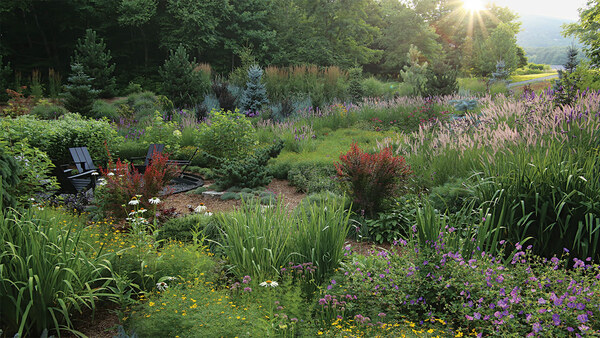Meadow gardens have been a long-lasting gardening “trend” that many have rushed to embrace. But most spaces can look more wild than curated. This garden, owned by Jay Sifford, an award-wining designer from North Carolina, shows how a landscape can encompass all the good attributes of a meadow garden (pollinator friendly, native plant inclusion, low-impact creation) while refining the less desirable attributes (messy, one season of appeal, no place for human interaction).
In this video, Jay explains why he chose to design a meadow garden in the first place. He describes the location of the soon-to-be garden and how that influenced what its design would be.
Although traditional meadows are largely planted along a flat plane (akin to a prairie), Jay’s meadow is laid out in a bowl-like fashion. This was partly due to topographical challenges from site work, but also because of his desire to make the meadow a place where people were embraced by the garden. Here are some of the steps Jay took in creating this garden.
Step 1: Install a roadside berm
A mounded hill helped keep water from running off the road and across the septic field. It also provided a greater degree of privacy and created better drainage for the conifers and grasses planted near the road. The overall bowl shape of the new garden acts as a nurturing space, providing the opportunity to create the seating area at the epicenter as kind of a stage in an amphitheater. The eye is intentionally directed downward (by gravel and mulch pathways—sometimes turning to avoid spilling plants), giving the space “labyrinth” vibes. All of this is designed to slow the garden visitor down. Once you are seated in the Adirondack chairs at the bottom, however, your eye is drawn upward by the trees and vertical grasses to the sky, since eyes follow shapes.
Step 2: Plant select species in rhythmic patterns
People seek simplicity in patterns. Therefore, Jay started planting the meadow design by laying out prominent shapes. A grouping, or shape, may be comprised of 150 ornamental grasses, for example, but the human brain reads that as one unit, not 150 individual units. The plants selected needed to provide at least two out of the following three attributes: structure, seasonal appeal, and/or pollinator-friendliness. There is a mix of native and nonnative plants.
Step 3: Ensure there are four seasons of interest
One particularly vexing issue with traditional meadows is that in winter they don’t look like much. This presents aesthetic problems for a home gardener who wants the landscape to look good, even in the off-season. Jay’s meadow is located in the front of his home (a very prominent location), and because of the large glass windows of the house, there is always a direct view to the meadow—even in winter. To ensure 12-months of interest, Jay has done several things. He has left the ornamental grasses up until early March to enjoy watching them dance kinetically in the wind. He has planted many nontraditional meadow garden plants such as conifers and other evergreens. And he has made sure the overall layout of the beds and hardscape provide a strong silhouette. So even when much of the plant material has died back, the outline remains constant.
More on stylized meadow gardens:
- Traditional vs. Stylized Meadow Gardens
- Planting Plan for a Stylized Meadow
- How to Design a Stylized Meadow Garden
To see more of Jay’s garden, check out his Garden Photo of the Day submissions:



















Comments
Beautiful garden. I appreciate your commentary which will helpful for me in planning the next step in my garden. I particularly love your conifers. I have many of the same conifers in my garden here in Michigan.
In addition to this beautiful meadow garden, I'm admiring the sculptural elements - the blue spires/spikes which look to me sort of like the beautiful glass art of Chihuly....and I'm wondering if these are commercially available for sale or are 'one of a kind' made feature ?
Log in or create an account to post a comment.
Sign up Log in